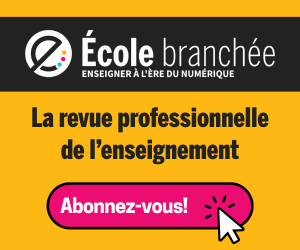Certains diront que c’est tout simple, qu’il suffisait d’y penser! Justement Marie-Philippe Goyer, orthopédagogue et conseillère pédagogique, ainsi que Marie-Ève Cypihot, enseignante en 3e année et étudiante à la maîtrise, utilisent la tablette numérique comme outil pour favoriser les compétences orales des élèves présentant des difficultés particulières au niveau du langage.
Les deux complices à l’École St-Joseph de Montréal ont même remporté en mai dernier, lors du gala des prix Innovation de la Fédération de l’enseignement des établissements privés (FEEP), la première place dans la catégorie « Innovation – Soutien aux élèves ayant des défis particuliers » avec le projet de maîtrise de Mme Cypihot : La technologie comme outil de différenciation pédagogique dans l’enseignement de la communication orale pour les élèves HDAA (handicap ou en difficulté d’adaptation ou d’apprentissage).
Pourquoi un tel projet? Parce que les observations de l’une et l’autre, qui sont toutes les deux enseignantes, vont dans le même sens : les présentations orales sont parfois une compétence insuffisamment préparée par rapport à d’autres aspects de l’enseignement, en raison notamment du classique manque de temps. Très souvent, la seule consigne que reçoivent les enfants, c’est : « Préparez votre présentation orale à la maison! ».
Par contre, elles étaient convaincues que si l’élève avait la possibilité de se reprendre, de se pratiquer avant sa présentation comme il ou elle le fait en se relisant avant de donner sa copie, peut-être que l’oral serait moins stressant, voire plus stimulant. C’est encore plus vrai pour les élèves HDAA.
Autoscopie techno
À partir du principe que l’autoscopie, une pratique consistant à donner une image de soi grâce, par exemple, à un enregistrement vidéo, le duo Goyer-Cypihot a misé sur les tablettes numériques pour améliorer les performances orales d’élèves de 5e et 6e année.
En étant filmé et en ayant la possibilité de se regarder par la suite, l’élève devant faire la présentation peut porter un jugement sur son intonation, ou encore sa posture.
Marie-Philippe Goyer, qui au moment de la recherche était titulaire d’une classe d’élèves ayant des troubles d’apprentissage, explique qu’il est important « que les élèves sachent ce sur quoi ils doivent travailler » quand ils vont se réécouter. C’est pour cela que sa collègue Marie-Ève a créé des mini-leçons afin qu’ils puissent identifier différentes composantes d’une présentation orale réussie.
Dans l’expérience menée à l’École St-Joseph, où les deux femmes ont filmé les élèves en train de se filmer, elles ont remarqué que les pairs qui donnaient des rétroactions à leurs camarades le faisaient de façon respectueuse. Marie-Philippe y allait aussi, bien sûr, de ses recommandations.
Et les résultats?
Habiles déjà dans la manipulation des tablettes numériques, les élèves auront pris en moyenne deux heures pour vivre l’expérience.
L’enseignante de 3e année, qui avait élaboré au départ une grille d’analyse avec des points bien précis à observer, estime que chaque élève s’est amélioré « d’un bon 10 % minimum ».
Elle ajoute que le projet a démontré que les élèves étaient également autonomes. Comme il n’y a pas de tablettes pour chacun, il fallait que les enfants soient en mesure de gérer celle assignée à leur petit groupe ou à leur équipe. Marie-Ève Cypihot ajoute aussi que la tablette possède l’avantage d’être mobile, donc facilement déplaçable dans la classe.
Y aura-t-il une suite à cette recherche? Si Mme Goyer espère partager la bonne nouvelle avec les autres collègues de son école, une chose est sûre : « Je ne reviendrai pas en arrière! ».
L’utilisation des tablettes numériques dans le cadre de l’apprentissage des compétences orales l’a convaincue de la nécessité d’intégrer à l’enseignement un tel outil. Il ne fait pas de doute pour les deux enseignantes : entre la première et la 3e ou 4e prise, il y a eu toute une amélioration!
Sur l’image à la une :
La technologie comme outil de différenciation pédagogique dans l’enseignement de la communication orale pour les élèves HDAA.
Crédit : courtoisie École St-Joseph
En complément :
Dans le numéro de l’automne 2022 du magazine École branchée, retrouvez l’article Enregistrer ses lectures et les partager pour recevoir des conseils : Une pratique qui améliore la fluence en lecture (réservé aux abonnés du magazine). Vous n’êtes pas abonnés? Suivez ce lien.









